Tale of Two Cities: How Nature-Based Solutions Help Create Adaptive and Resilient Urban Water Management Practices in Singapore and Lisbon
Abstract
:1. Introduction
- Increase water availability through managing precipitation, humidity, and water storage, infiltration, and transmission;
- Improve water quality through source water protection—forests, wetlands, and grasslands—regulating water quality by reducing sediment loadings, capturing and retaining pollutants, and recycling nutrients;
- Reduce water-related risks through water retention to reduce exposure to floods and droughts.
2. Materials and Methods
2.1. Overview of Common Nature-Based Solutions for Urban Water Management
2.1.1. Wetlands
2.1.2. Sustainable Drainage Systems
2.1.3. River Parks
2.2. Study Areas
2.2.1. Singapore
2.2.2. Lisbon
2.3. Methods
3. Results
3.1. The Experience of NbS in Singapore
3.1.1. Integrated Planning for Water Supply
3.1.2. NbS for Flood Control
3.1.3. NbS for Coastal Protection
3.1.4. NbS in Urban Design
3.2. The Experience of NbS in Lisbon
3.2.1. Integrated Planning for Wastewater Reuse
- The axis Parque Eduardo VII–Cidade Universitária (numbers 1 to 3 in Figure 6);
- The Chelas Valley (number 6 in Figure 6).
3.2.2. NbS for Flood Control
3.2.3. Other NbS for Green and Recreational Areas
4. Discussion
4.1. From Civil Engineering to Nature Building
4.2. The Common Drivers
4.3. Pluralism in Spatial Planning
4.4. Mindset Shift
4.5. Whole-of-Government Approach
4.6. Limitations of Study
5. Conclusions
Supplementary Materials
Author Contributions
Funding
Institutional Review Board Statement
Informed Consent Statement
Data Availability Statement
Acknowledgments
Conflicts of Interest
References
- Food and Agriculture Organization of the United Nations. Water Use. Available online: http://www.fao.org/aquastat/en/overview/methodology/water-use (accessed on 20 January 2021).
- Kulp, S.A.; Strauss, B.H. New Elevation Data Triple Estimates of Global Vulnerability to Sea-Level Rise and Coastal Flooding. Nat. Commun. 2019, 10, 4844. [Google Scholar] [CrossRef] [Green Version]
- WWAP (United Nations World Water Assessment Programme)/UN-Water. The United Nations World Water Development Report 2018: Nature-Based Solutions for Water; UNESCO: Paris, France, 2018. [Google Scholar]
- Ramírez-Agudelo, N.A.; Anento, R.P.; Villares, M.; Roca, E. Nature-Based Solutions for Water Management in Peri-Urban Areas: Barriers and Lessons Learned from Implementation Experiences. Sustainability 2020, 12, 9799. [Google Scholar] [CrossRef]
- La Rosa, D.; Pappalardo, V. Planning for spatial equity—A performance based approach for sustainable urban drainage systems. Sustain. Cities Soc. 2020, 53, 101885. [Google Scholar] [CrossRef]
- Gunnell, K.; Mulligan, M.; Francis, R.A.; Hole, D.G. Evaluating natural infrastructure for flood management within the watersheds of selected global cities. Sci. Total Environ. 2019, 670, 411–424. [Google Scholar] [CrossRef]
- Ronchi, S.; Arcidiacono, A.; Pogliani, L. Integrating green infrastructure into spatial planning regulations to improve the performance of urban ecosystems. Insights from an Italian case study. Sustain. Cities Soc. 2020, 53, 101907. [Google Scholar] [CrossRef]
- Belčáková, I.; Świąder, M.; Bartyna-Zielińska, M. The green infrastructure in cities as a tool for climate change adaptation and mitigation: Slovakian and polish experiences. Atmosphere 2019, 10, 552. [Google Scholar] [CrossRef] [Green Version]
- Cortinovis, C.; Zulian, G.; Geneletti, D. Assessing nature-based recreation to support urban green infrastructure planning in Trento (Italy). Land 2018, 7, 112. [Google Scholar] [CrossRef] [Green Version]
- Thorslund, J.; Jarsjo, J.; Jaramillo, F.; Jawitz, J.W.; Manzoni, S.; Basu, N.B.; Chalov, S.R.; Cohen, M.J.; Creed, I.F.; Goldenberg, R.; et al. Wetlands as Large-Scale Nature-Based Solutions: Status and Challenges for Research, Engineering and Management. Ecol. Eng. 2017, 108, 489–497. [Google Scholar] [CrossRef]
- Masi, F.; Rizzo, A.; Regelsberger, M. The Role of Constructed Wetlands in a New Circular Economy, Resource Oriented, and Ecosystem Services Paradigm. J. Environ. Manag. 2018, 216, 275–284. [Google Scholar] [CrossRef]
- Amaral, R.; Ferreira, F.; Galvao, A.; Matos, J.S. Constructed wetlands for combined sewer overflow treatment in a Mediterranean country, Portugal. Water Sci. Technol. 2013, 67, 2739–2745. [Google Scholar] [CrossRef]
- Woods-Ballard, B.; Kellagher, R.; Martin, P.; Jefferies, C.; Bray, R.; Shaffer, P. The SuDS Manual, 2nd ed.; CIRIA: London, UK, 2015. [Google Scholar]
- Marie, B.; Luz, F.; Panagopoulos, T. Urban River Recovery Inspired by Nature-Based Solutions and Biophilic Design in Albufeira, Portugal. Land 2018, 7, 141. [Google Scholar]
- Gaw, L.Y.F.; Yee, A.T.K.; Richards, D.R. A High-Resolution Map of Singapore’s Terrestrial Ecosystems. Data 2019, 4, 116. [Google Scholar] [CrossRef] [Green Version]
- National Environment Agency. Climate of Singapore. Available online: http://www.weather.gov.sg/climate-climate-of-singapore/ (accessed on 8 July 2021).
- Chow, W.T.L.; Cheong, B.D.; Ho, B.H. A Multimethod Approach towards Assessing Urban Flood Patterns and Its Associated Vulnerabilities in Singapore. Adv. Meteorol. 2016, 2016, 7159132. [Google Scholar] [CrossRef]
- Carvalho, A.; Schmidt, L.; Santos, F.D.; Delicado, A. Climate change research and policy in Portugal. Wiley Interdiscip. Rev. Clim. Chang. 2014, 5, 199–217. [Google Scholar]
- IPMA. Boletim Climatológico Sazonal Verão. 2019. Available online: https://www.ipma.pt/resources.www/docs/im.publicacoes/edicoes.online/20191115/tnUkmwJWSsRAdUmUVwgK/cli_20190601_20190831_pcl_sz_co_pt.pdf (accessed on 11 June 2021).
- Câmara Municipal de Lisboa. European Green Capital Lisboa. 2020. Available online: https://ec.europa.eu/environment/europeangreencapital/wp-content/uploads/2018/07/EGCA2020_Lisbon_Presentation.pdf (accessed on 7 May 2020).
- National Research Foundation. Natural Capital Singapore. Available online: http://www.naturalcapital.sg/ (accessed on 14 June 2021).
- Tan, A. New Research Centre on Nature-Based Solutions for Climate Change to Open in NUS by End-2020. Available online: https://www.straitstimes.com/singapore/environment/new-research-centre-on-nature-based-solutions-for-climate-change-to-open-in (accessed on 13 June 2021).
- Singapore Green Plan. Available online: https://www.greenplan.gov.sg/key-focus-areas/vision/ (accessed on 13 June 2021).
- Public Utilities Board. PUB, Singapore’s Water Story. Available online: https://www.pub.gov.sg/ (accessed on 29 May 2021).
- Center for Livable Cities. Four National Taps. Available online: https://eresources.nlb.gov.sg/infopedia/articles/SIP_2019-05-24_170025.html (accessed on 22 January 2021).
- Active, Beautiful, Clean Waters (ABC Waters) Programme|Infopedia. Available online: https://eresources.nlb.gov.sg/infopedia/articles/SIP_2019-08-21_203240.html (accessed on 8 June 2021).
- Yau, W.; Radhakrishnan, M.; Liong, S.-Y.; Zevenbergen, C.; Pathirana, A. Effectiveness of ABC Waters Design Features for Runoff Quantity Control in Urban Singapore. Water 2017, 9, 577. [Google Scholar] [CrossRef] [Green Version]
- Center for Livable Cities. Bishan-Ang Mo Kio Park. Available online: https://eresources.nlb.gov.sg/infopedia/articles/SIP_2019-08-27_142843.html (accessed on 22 January 2021).
- Wilkinson, C.L.; Kwik, J.T.B.; Ow, A.M.W.; Lim, R.B.H.; Liu, S.; Tan, C.L.Y.; Saw, A.C.Y.; Liew, J.H.; Yeo, D.C.J. Rehabilitation of a Tropical Storm-Water Drain Creates a Novel Fish Assemblage. Ecol. Eng. 2021, 161, 106150. [Google Scholar] [CrossRef]
- Theng, M.; Sivasothi, N. The smooth-coated otter Lutrogale perspicillata (Mammalia: Mustelidae) in Singapore: Establishment and expansion in natural and semi-urban environments. IUCN Otter Spec. Group Bull 2016, 33, 37–49. [Google Scholar]
- Khoo, M.D.Y.; Lee, B.P.Y.-H. The Urban Smooth-Coated Otters Lutrogale Perspicillata of Singapore: A Review of the Reasons for Success. Int. Zoo Yearb. 2020, 54, 60–71. [Google Scholar] [CrossRef]
- Bishan-Ang Mo Kio Park|2016 ASLA Professional Awards. Available online: https://www.asla.org/2016awards/169669.html (accessed on 12 August 2021).
- Mohan, M. Engineering Solutions to Tackle Rising Sea Levels Important but More Research Vital: Experts. Available online: https://www.channelnewsasia.com/singapore/climate-change-rising-sea-levels-research-poldering-ndr2019-1338391 (accessed on 12 July 2021).
- Gijsman, R.; Horstman, E.M.; van der Wal, D.; Friess, D.A.; Swales, A.; Wijnberg, K.M. Nature-Based Engineering: A Review on Reducing Coastal Flood Risk With Mangroves. Front. Mar. Sci. 2021, 8, 825. [Google Scholar] [CrossRef]
- Tan, A.; Fogarty, D. Singapore Will Use Nature-Based Solutions to Deal with Sea Level Rise: Masagos. Available online: https://www.straitstimes.com/singapore/environment/singapore-will-incorporate-nature-based-solutions-that-go-beyond-coastal (accessed on 14 June 2021).
- National Parks Board. Mangroves. Available online: https://www.nparks.gov.sg/biodiversity/our-ecosystems/coastal-and-marine/mangroves (accessed on 14 June 2021).
- National Parks Board. OneMillionTrees Movement. Available online: https://www.nparks.gov.sg/treessg/one-million-trees-movement (accessed on 14 June 2021).
- Tan, P.Y.; Liao, K.H.; Hwang, Y.H.; Chua, V. (Eds.) Nature, Place & People: Forging Connections Through Neighbourhood Landscape Design; World Scientific: Singapore, 2018. [Google Scholar]
- Tan, B.A.; Gaw LY, F.; Masoudi, M.; Richards, D.R. Nature-Based Solutions for Urban Sustainability: An Ecosystem Services Assessment of Plans for Singapore’s First “Forest Town”. Front. Environ. Sci. 2021, 9, 610155. [Google Scholar] [CrossRef]
- Newman, P. Biophilic Urbanism: A Case Study on Singapore. Aust. Plan. 2014, 51, 47–65. [Google Scholar] [CrossRef]
- Manso, M.; Teotónio, I.; Silva, C.M.; Cruz, C.O. Green Roof and Green Wall Benefits and Costs: A Review of the Quantitative Evidence. Renew. Sustain. Energy Rev. 2021, 135, 110111. [Google Scholar] [CrossRef]
- Plano Geral de Drenagem de Lisboa 2016–2030. Available online: https://www.lisboa.pt/fileadmin/cidade_temas/ambiente/qualidade_ambiental/documentos/PGDL2_Relatorio_FINAL.pdf (accessed on 30 January 2021).
- European Commission, Communication from the Commission to the European Parliament, the Council, the European Economic and Social Committee and the Committee of the Regions, A Blueprint to Safeguard Europe’s Water Resources. Available online: https://eur-lex.europa.eu/legal-content/EN/ALL/?uri=CELEX%3A52012DC0673 (accessed on 11 June 2021).
- European Commission, Proposal for a Regulation of the European Parliament and of the Council on Minimum Re-quirements for Water Reuse. Available online: https://ec.europa.eu/environment/water/pdf/water_reuse_regulation.pdf (accessed on 15 January 2021).
- Lisboa E-Nova, Matriz da Água de Lisboa 2014. Available online: https://lisboaenova.org/matriz-da-agua-de-lisboa-2014/ (accessed on 9 June 2021).
- Hidra—Hidráulica e Ambiente. Plano Estratégico de Reutilização de Água da Cidade de Lisboa. In Proceedings of the Câmara Municipal de Lisboa, Lisboa, Portugal, 12 July 2019. [Google Scholar]
- Husqvarna Urban Green Space Index. Quantifying the Greenness of Global Cities. Available online: https://www.hugsi.green/city/?Lisbon (accessed on 20 May 2021).
- The World Bank. World Development Indicators. Available online: https://datatopics.worldbank.org/world-development-indicators/ (accessed on 15 May 2021).
- Hoegh-Guldberg, O.; Jacob, D.; Taylor, M.; Bindi, M.; Brown, S.; Camilloni, I.; Diedhiou, A.; Djalante, R.; Ebi, K.L.; Engelbrecht, F.; et al. Impacts of 1.5 °C Global Warming on Natural and Human Systems. In Global Warming of 1.5°C. An IPCC Special Report on the Impacts of Global Warming of 1.5 °C above Pre-Industrial Levels and Related Global Greenhouse Gas Emission Pathways, in the Context of Strengthening the Global Response to the Threat of Climate Change, Sustainable Development, and Efforts to Eradicate Poverty; Masson-Delmotte, V.P., Zhai, H.-O., Pörtner, D., Roberts, J., Skea, P.R., Shukla, A., Pirani, W., Moufouma-Okia, C., Péan, R., Pidcock, S., et al., Eds.; IPCC: Geneva, Switzerland, 2018. [Google Scholar]
- Drillet, Z.; Fung, T.K.; Leong, R.A.T.; Sachidhanandam, U.; Edwards, P.; Richards, D. Urban Vegetation Types Are Not Perceived Equally in Providing Ecosystem Services and Disservices. Sustainability 2020, 12, 2076. [Google Scholar] [CrossRef] [Green Version]
- Tan, C.L.Y.; Chang, C.-C.; Nghiem, L.T.P.; Zhang, Y.; Oh, R.R.Y.; Shanahan, D.F.; Lin, B.B.; Gaston, K.J.; Fuller, R.A.; Carrasco, L.R. The Right Mix: Residential Urban Green-Blue Space Combinations Are Correlated with Physical Exercise in a Tropical City-State. Urban For. Urban Green. 2021, 57, 126947. [Google Scholar] [CrossRef]
- Richards, D.R.; Edwards, P.J. Using Water Management Infrastructure to Address Both Flood Risk and the Urban Heat Island. Int. J. Water Resour. Dev. 2018, 34, 490–498. [Google Scholar] [CrossRef]
- Public Utilities Board. Active, Beautiful, Clean Waters Program—Certified Projects 2010–2018; Public Utilities Board: Singapore, 2019. [Google Scholar]
- Tan, A. Singapore Green Plan 2030 to Change the Way People Live, Work, Study and Play. Available online: https://www.straitstimes.com/singapore/environment/singapore-green-plan-2030-to-change-the-way-people-live-work-study-and-play (accessed on 15 May 2021).
- Ng, M. S’pore to Relook Long-Term Approach to Land Use, Planning; Engagement for Review to Start in July, Says Desmond Lee. Available online: https://www.straitstimes.com/singapore/spore-to-relook-long-term-approach-to-land-use-planning-engagement-for-review-to-start (accessed on 15 May 2021).
- Mahmoud, I.; Morello, E. Co-creation Pathway for Urban Nature-Based Solutions: Testing a Shared-Governance Approach in Three Cities and Nine Action Labs. In Smart and Sustainable Planning for Cities and Regions; Green Energy and, Technology; Bisello, A., Vettorato, D., Ludlow, D., Baranzelli, C., Eds.; Springer: Cham, Switzerland, 2019. [Google Scholar]
- Kabisch, N.; Korn, H.; Stadler, J.; Bonn, A. Nature-Based Solutions to Climate Change Adaptation in Urban Areas—Linkages between Science; Policy and Practice; Springer: Cham, Switzerland, 2017. [Google Scholar]
- World Resources Institute. Collaboration on Nature-Based Solutions Is Key to Resilient City Infrastructure. Available online: https://www.wri.org/blog/2020/06/collaboration-nature-based-solutions-city-agencies (accessed on 22 January 2021).
- Zingraff-Hamed, A.; Hüesker, F.; Albert, C.; Brillinger, M.; Huang, J.; Lupp, G.; Scheuer, S.; Schlätel, M.; Schröter, B. Governance models for nature-based solutions: Seventeen cases from Germany. Ambio 2021, 50, 1610–1627. [Google Scholar] [CrossRef] [PubMed]
- Richards, D.; Fung, T.K.; Belcher, R.; Edwards, P. Differential Air Temperature Cooling Performance of Urban Vegetation Types in the Tropics. Urban For. Urban Green. 2020, 50, 126651. [Google Scholar] [CrossRef]
- Teo, H.C.; Zeng, Y.; Sarira, T.V.; Fung, T.K.; Zheng, Q.; Song, X.P.; Chong, K.Y.; Koh, L.P. Global Urban Reforestation Can Be an Important Natural Climate Solution. Environ. Res. Lett. 2021, 16, 034059. [Google Scholar] [CrossRef]
- Song, X.P.; Tan, P.Y.; Edwards, P.; Richards, D. The Economic Benefits and Costs of Trees in Urban Forest Stewardship: A Systematic Review. Urban For. Urban Green. 2018, 29, 162–170. [Google Scholar] [CrossRef]

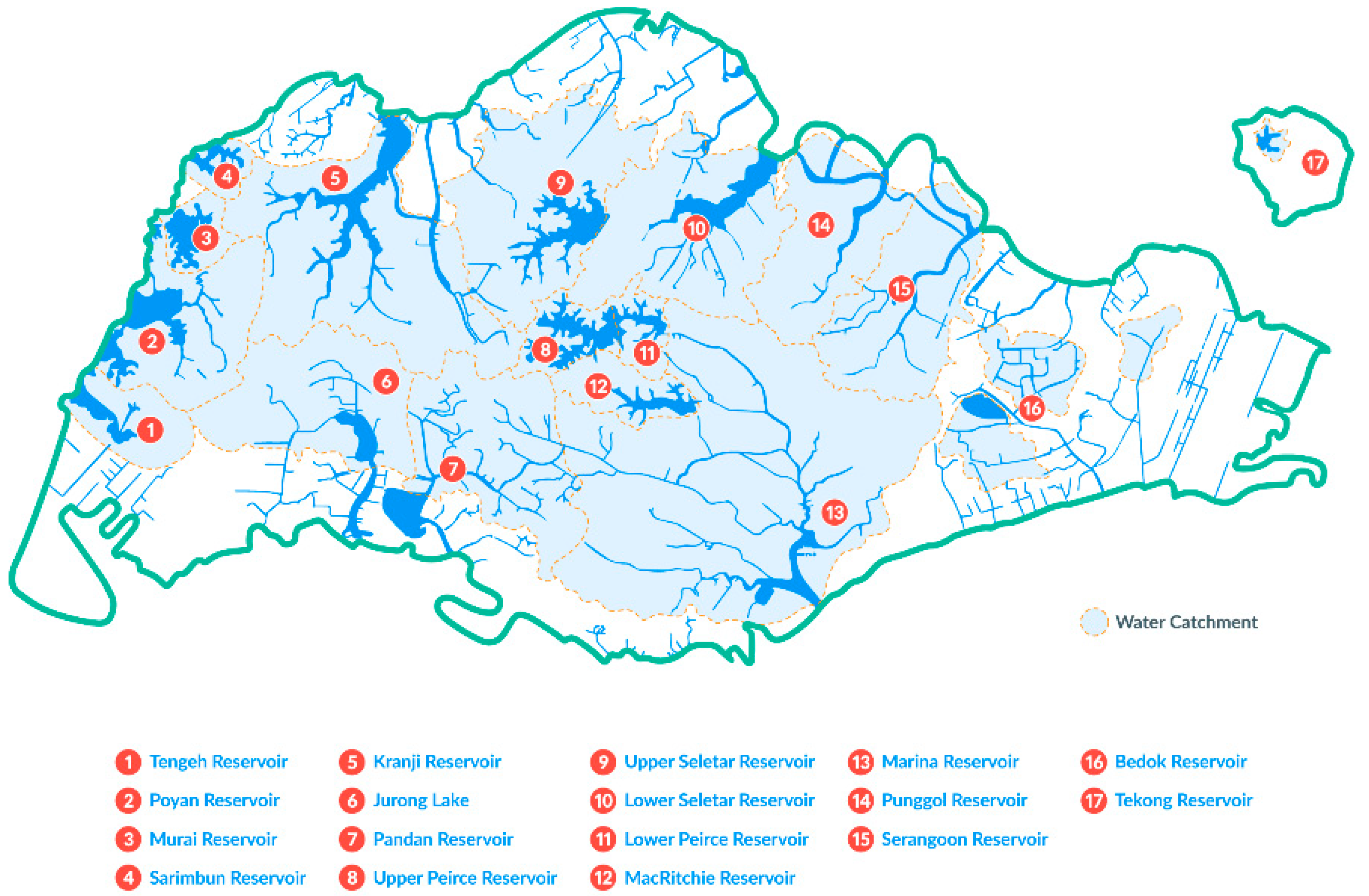
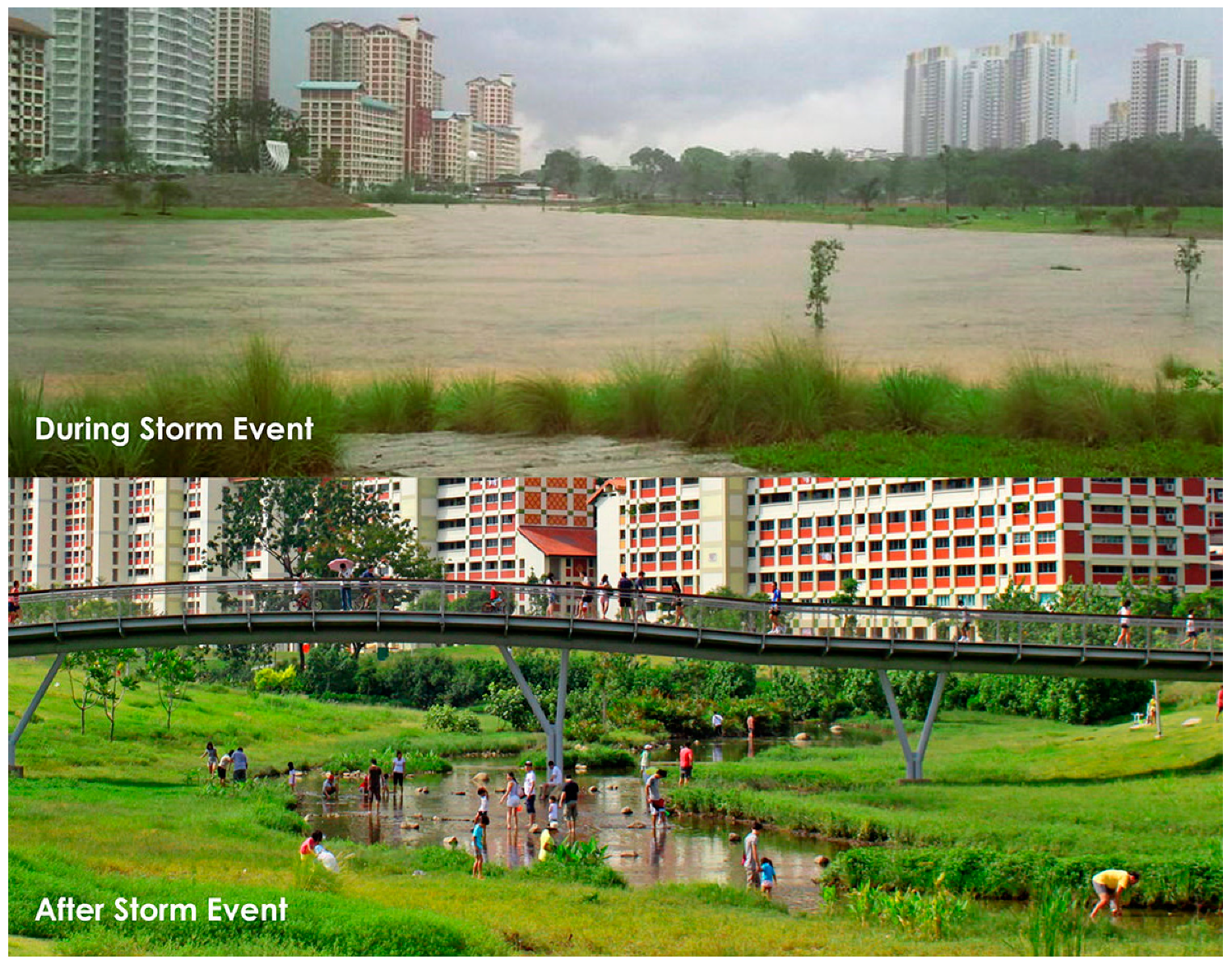
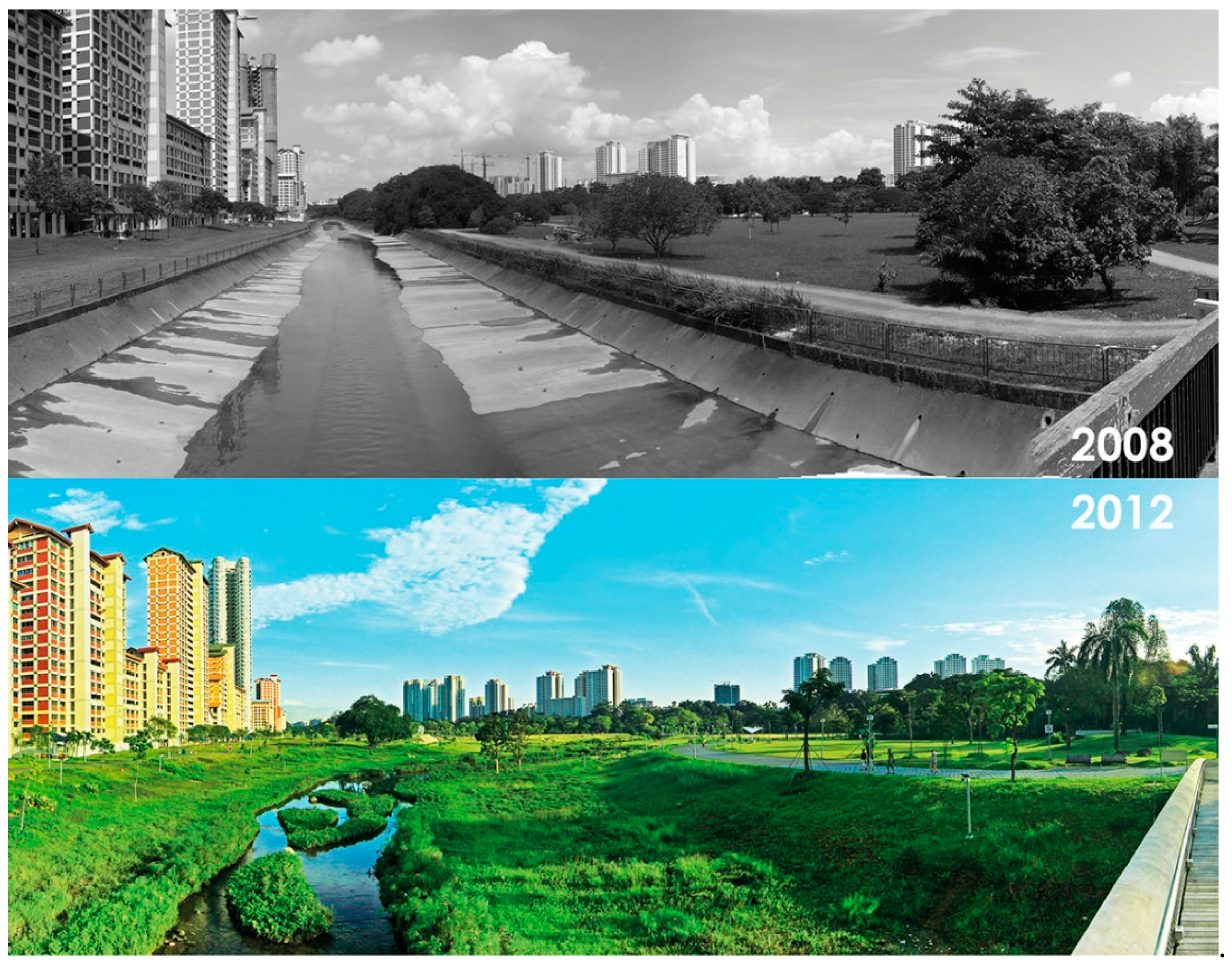

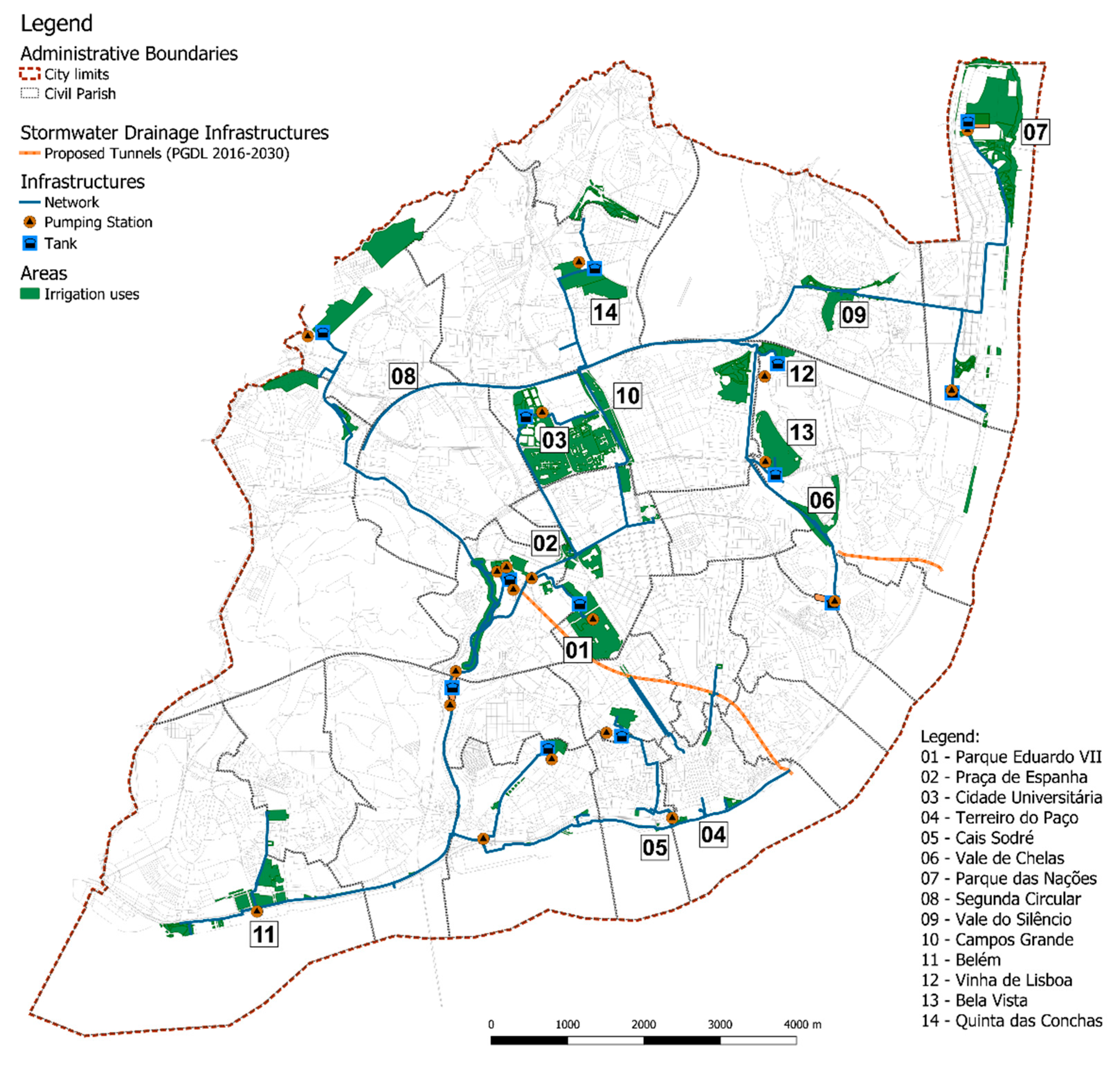

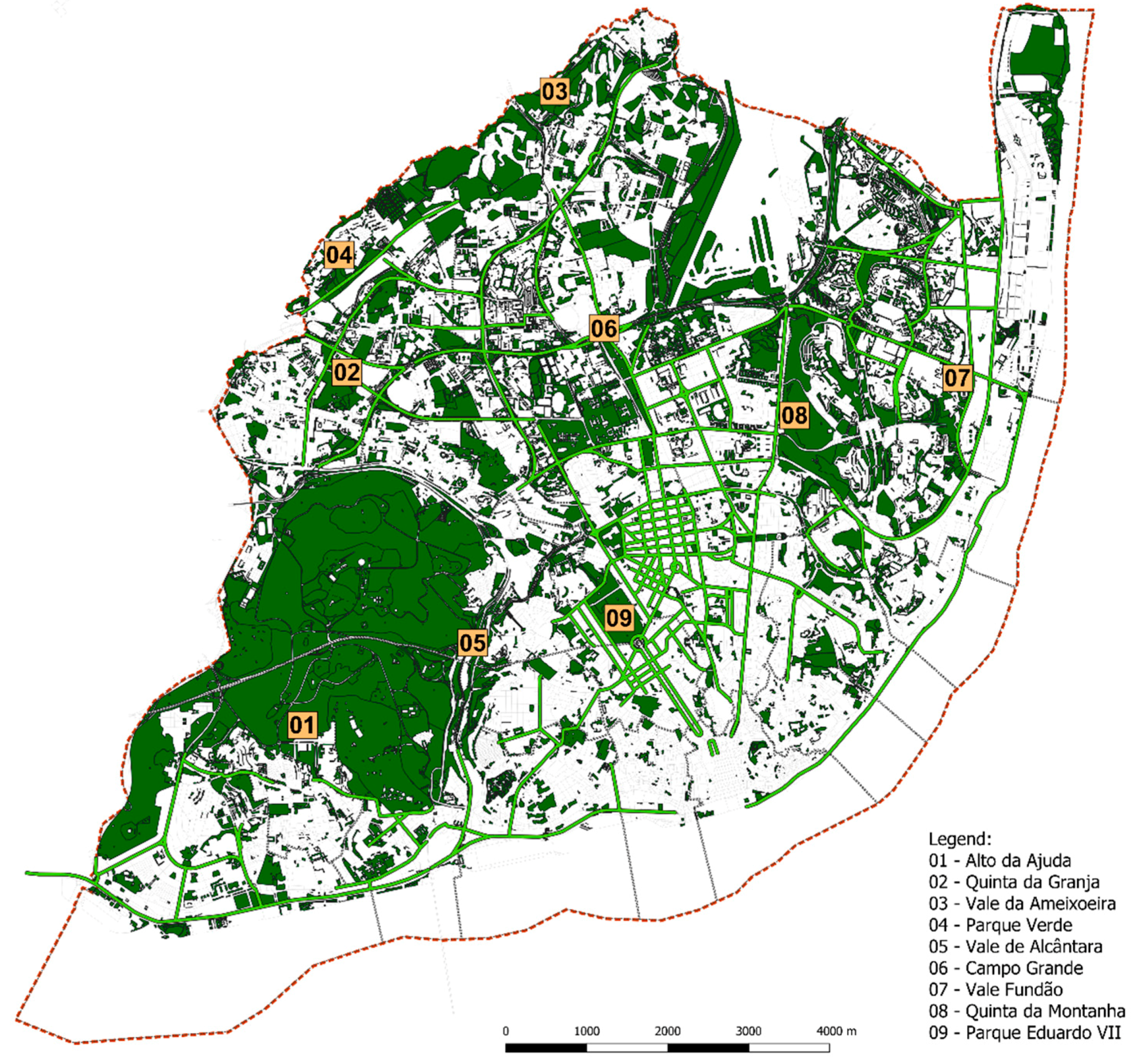
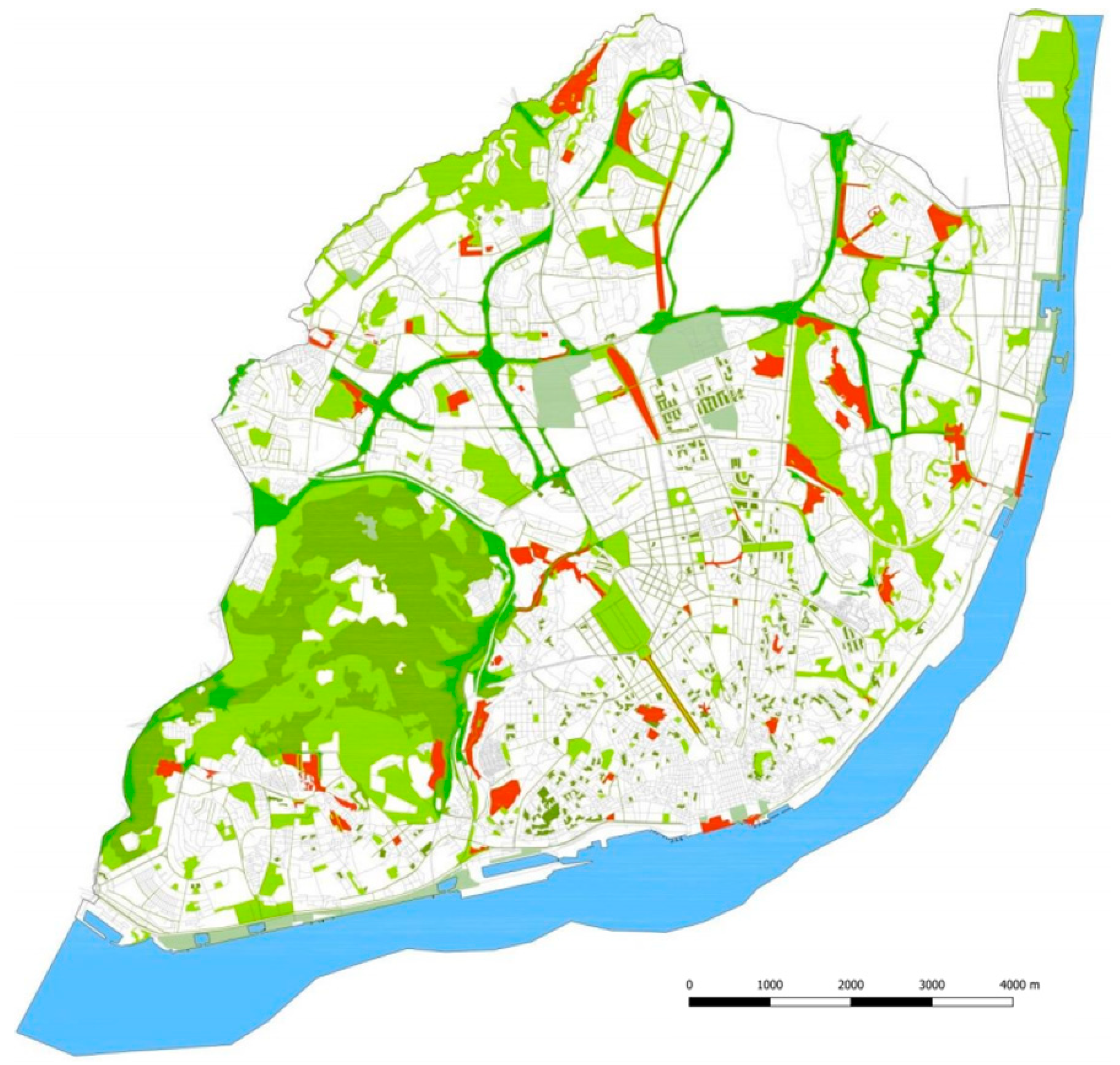
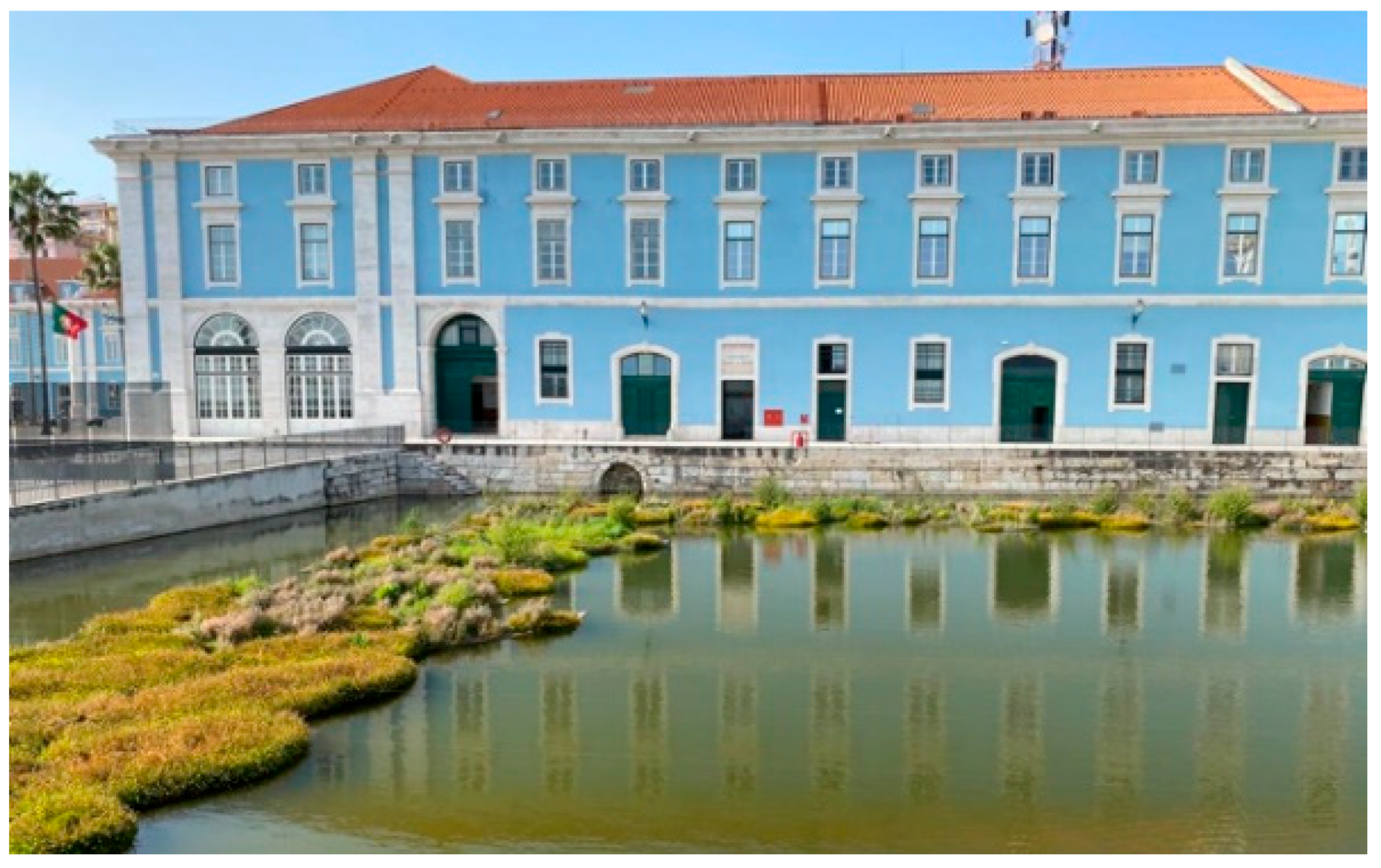

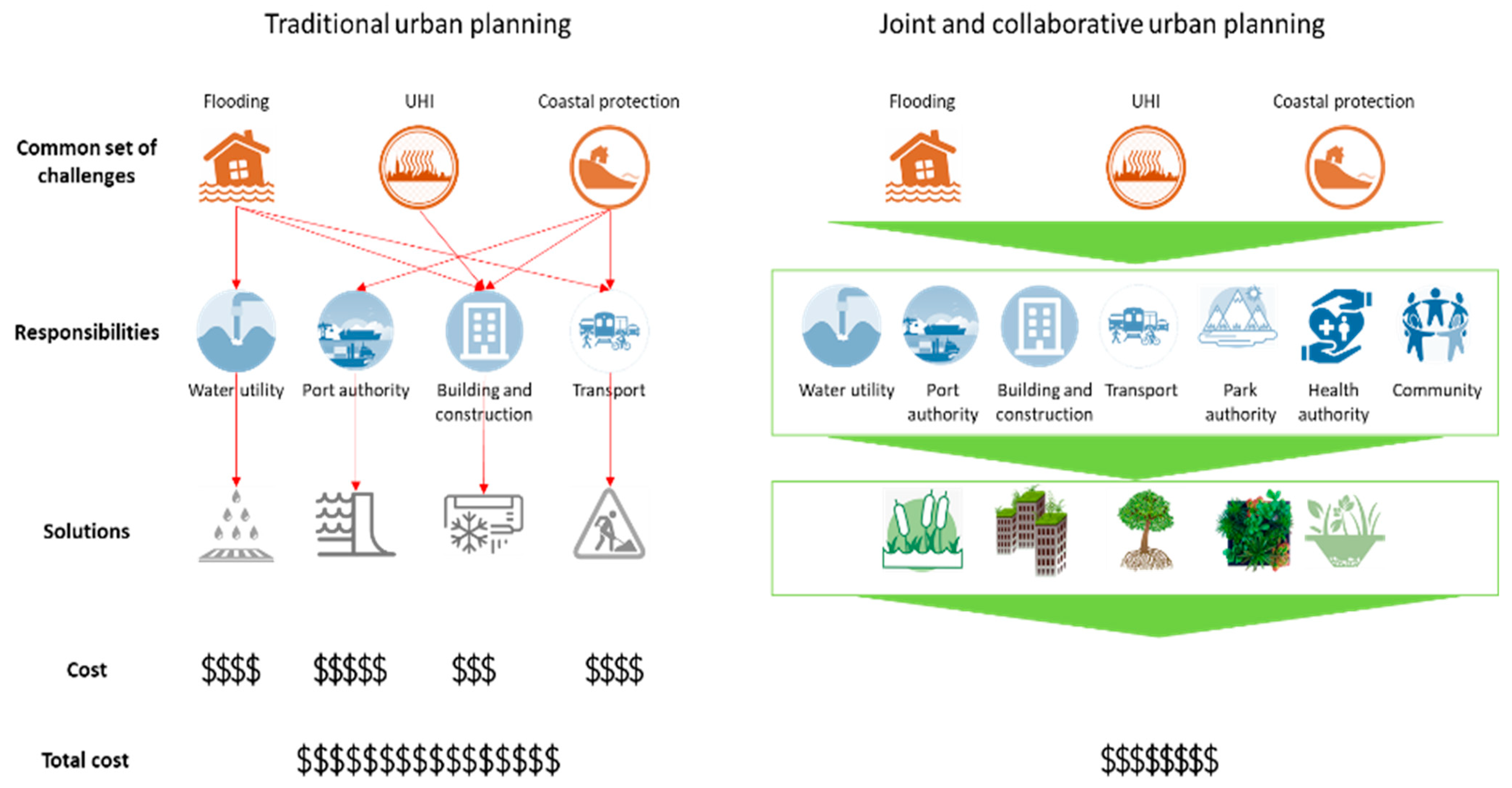
| Indicator | Singapore | Lisbon |
|---|---|---|
| Location | Southeast Asia | Southern Europe |
| Climate | Tropical | Mediterranean |
| Population | 5,685,000 inhabitants | 510,000 inhabitants |
| Population Density | 7810 inhabitants/km2 | 5959 inhabitants/km2 |
| Area | 725 km2 | 100 km2 |
| Per capita GDP | 89,547 SGD (56,246 EUR)/inhabitant | 26,900 EUR/inhabitant |
| Water resources | No fresh water except rainwater | Tagus River |
| Community structure | Planned townships with intentional communities built over the past 50 years | City civil parishes (organized communities are uncommon) |
| Stakeholders | Lead Agency or City Department | Support Agency or City Department | General Public | Coordinating Agency (Usually Reports Directly to the Highest Governance Body) | |
|---|---|---|---|---|---|
| RACI Category | |||||
| Responsible | √ | √ | |||
| Accountable | √ | ||||
| Consulted | √ | √ | |||
| Informed | √ | √ | |||
Publisher’s Note: MDPI stays neutral with regard to jurisdictional claims in published maps and institutional affiliations. |
© 2021 by the authors. Licensee MDPI, Basel, Switzerland. This article is an open access article distributed under the terms and conditions of the Creative Commons Attribution (CC BY) license (https://creativecommons.org/licenses/by/4.0/).
Share and Cite
Cui, M.; Ferreira, F.; Fung, T.K.; Matos, J.S. Tale of Two Cities: How Nature-Based Solutions Help Create Adaptive and Resilient Urban Water Management Practices in Singapore and Lisbon. Sustainability 2021, 13, 10427. https://doi.org/10.3390/su131810427
Cui M, Ferreira F, Fung TK, Matos JS. Tale of Two Cities: How Nature-Based Solutions Help Create Adaptive and Resilient Urban Water Management Practices in Singapore and Lisbon. Sustainability. 2021; 13(18):10427. https://doi.org/10.3390/su131810427
Chicago/Turabian StyleCui, Mengmeng, Filipa Ferreira, Tze Kwan Fung, and José Saldanha Matos. 2021. "Tale of Two Cities: How Nature-Based Solutions Help Create Adaptive and Resilient Urban Water Management Practices in Singapore and Lisbon" Sustainability 13, no. 18: 10427. https://doi.org/10.3390/su131810427
APA StyleCui, M., Ferreira, F., Fung, T. K., & Matos, J. S. (2021). Tale of Two Cities: How Nature-Based Solutions Help Create Adaptive and Resilient Urban Water Management Practices in Singapore and Lisbon. Sustainability, 13(18), 10427. https://doi.org/10.3390/su131810427









